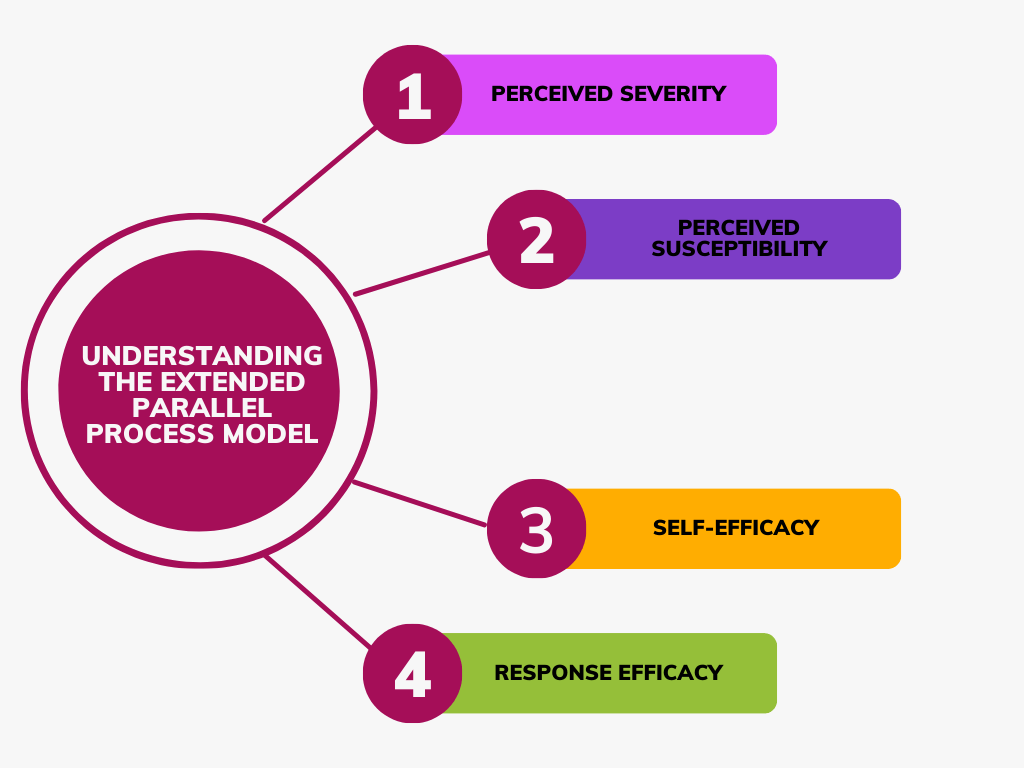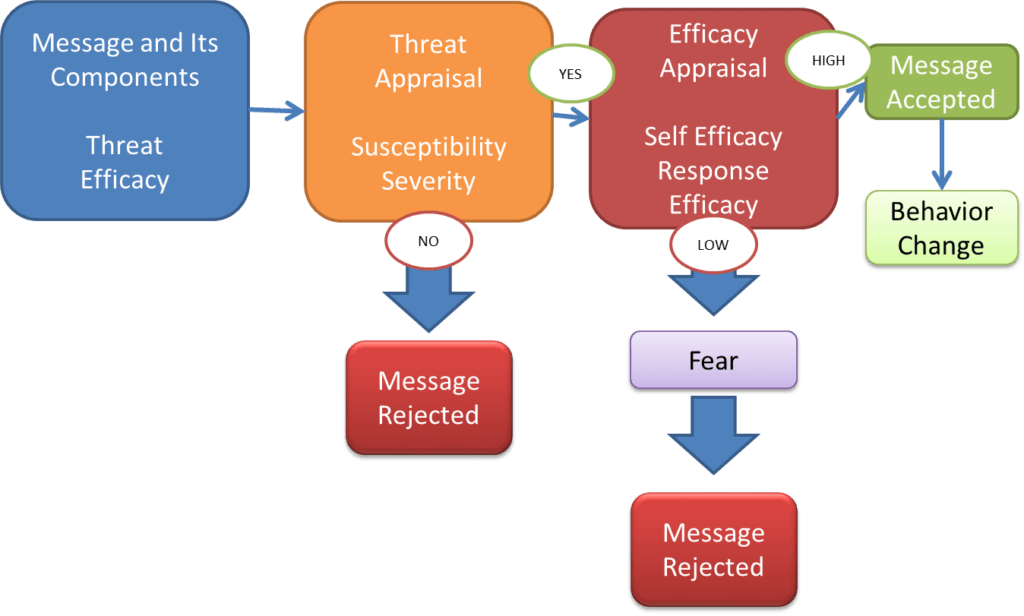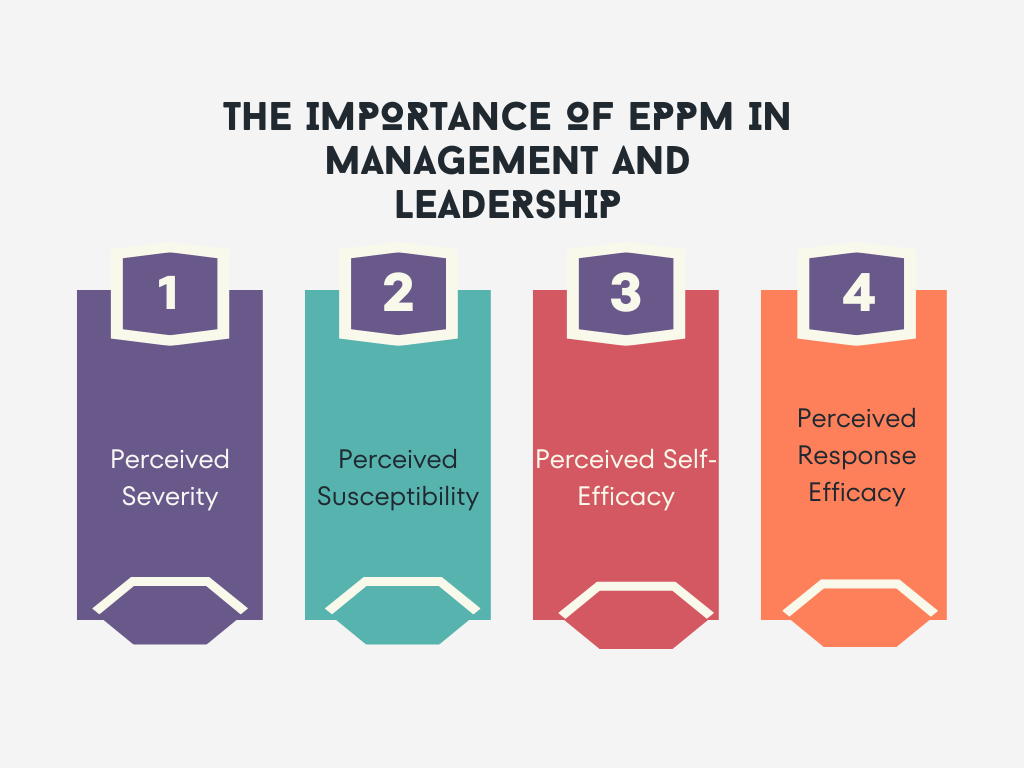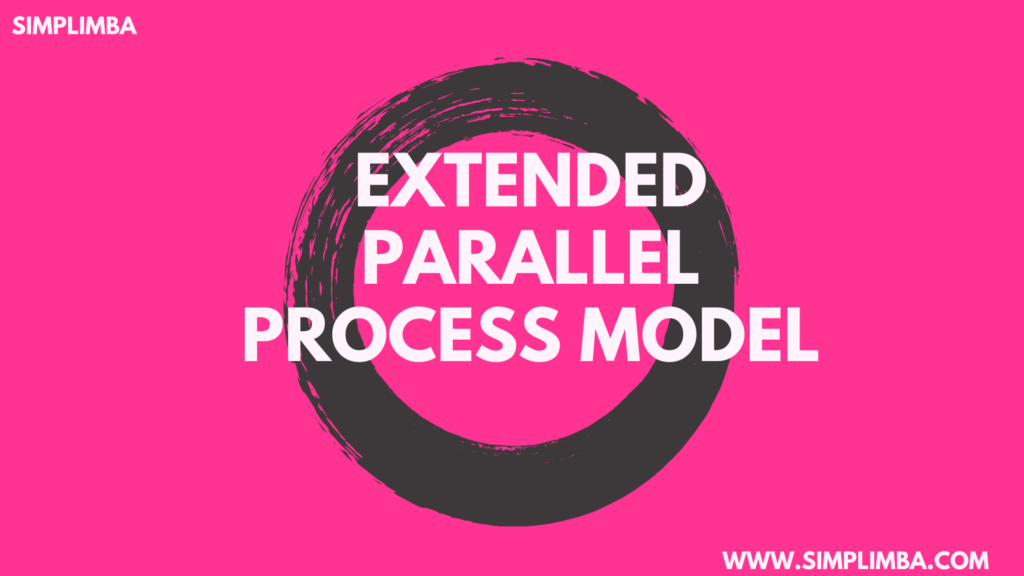Understanding the Extended Parallel Process Model (EPPM)
The Extended Parallel Process Model (EPPM) is a theory that explains how individuals process and respond to persuasive fear messages. Developed by Kim Witte, the EPPM suggests that when people are confronted with a threat, they first assess the severity of the threat (perceived severity) and their susceptibility to it (perceived susceptibility). If they perceive the threat as serious and relevant, they then evaluate their ability to effectively avert the threat (self-efficacy) and the effectiveness of the recommended action (response efficacy).

Perceived Severity
Perceived severity refers to an individual’s assessment of the seriousness of a threat. This assessment is influenced by both the objective severity of the threat (e.g., the potential harm it can cause) and the individual’s subjective interpretation of this severity. For example, a person might perceive a health threat like heart disease as severe because of its potential to cause death or severe disability.
To persuade individuals to take preventive action, copywriters often emphasize the potential negative consequences of inaction. This can be done using statistical data, personal stories, or vivid descriptions. However, it’s important to strike a balance to avoid causing excessive fear or anxiety, which can lead to defensive avoidance.
Perceived Susceptibility
Perceived susceptibility refers to an individual’s belief about their likelihood of experiencing a threat. This perception is influenced by factors such as personal health history, genetic predisposition, and lifestyle habits. For example, a smoker may perceive themselves as more susceptible to lung cancer than a non-smoker.
To increase perceived susceptibility, copywriters can use personalized risk assessments, comparisons, or testimonials. The goal is to make the threat feel relevant and personal, thus motivating the individual to take preventive action.
Self-Efficacy
Self-efficacy refers to an individual’s belief in their ability to perform a specific action to avert a threat. This belief is influenced by past experiences, perceived skills, and confidence. For example, a person who has successfully quit smoking in the past may have high self-efficacy for quitting smoking again.
To boost self-efficacy, copywriters can provide clear, step-by-step instructions, offer tools and resources, or share success stories. The aim is to make the individual feel capable and empowered to take action.
Response Efficacy
Response efficacy refers to an individual’s belief in the effectiveness of the recommended action to avert a threat. This belief is influenced by scientific evidence, expert opinions, and societal norms. For example, a person may believe that wearing a mask is effective in preventing the spread of COVID-19 because of the consensus among health experts.
To enhance response efficacy, copywriters can present credible evidence, quote experts, or show social proof. The objective is to convince the individual that the recommended action is not only doable but also worthwhile.
History and Background of EPPM

The Extended Parallel Process Model (EPPM) is a seminal theory in the field of communication and public health. Developed by Kim Witte in 1992, the EPPM has been instrumental in shaping our understanding of how fear appeals work in persuasive communication. Let’s delve deeper into its history, evolution, and the mechanics that make it tick.
Origins of the EPPM: The EPPM was born out of Kim Witte’s research in the field of health communication. Witte noticed that traditional models of fear appeals had a significant limitation: they didn’t account for the fact that individuals respond differently to fear-based messages. To address this, Witte proposed the EPPM, a model that considers both the perceived threat of a situation and the perceived efficacy of the recommended action.
Theoretical Underpinnings of the EPPM: The EPPM builds upon two established theories in psychology and communication: the Theory of Reasoned Action (TRA) and the Health Belief Model (HBM). The TRA posits that individuals’ behaviors are driven by their intentions, which are influenced by attitudes and subjective norms. The HBM, on the other hand, suggests that individuals’ health behaviors are influenced by perceived susceptibility to a health threat, perceived severity of the threat, perceived benefits of action, and perceived barriers to action. Witte integrated these theories to develop the EPPM, which considers both threat and efficacy in predicting responses to fear appeals.
Evolution of the EPPM: Over time, the EPPM has been refined and expanded to better understand and predict responses to fear appeals. For instance, researchers have explored the role of other variables, such as past experience with the threat, in shaping threat and efficacy perceptions. Moreover, the EPPM has been applied to a wide range of contexts beyond health communication, including environmental communication, cybersecurity, and marketing.
The Importance of EPPM in Management and Leadership
The EPPM holds significant value in management and leadership. It helps leaders understand how their team members perceive threats or challenges and how they respond to them. By understanding these perceptions, leaders can craft messages that effectively motivate their teams to take the necessary actions.

The Extended Parallel Process Model (EPPM) is a theory that suggests individuals’ responses to threats or challenges are influenced by their perceived severity of the threat, their perceived susceptibility to the threat, their perceived self-efficacy, and their perceived response efficacy. Let’s deep dive into each of these elements:
Perceived Severity: This refers to how serious an individual perceives the threat or challenge to be. If the perceived severity is high, they are more likely to take action. For instance, if a team member perceives a project delay as a severe threat to their job security, they are more likely to work overtime to meet the deadline. Leaders can use this understanding to craft messages that accurately convey the severity of a situation. For example, in a sales context, a copywriter might emphasize the consequences of not purchasing a product or service, thereby increasing the perceived severity and inducing the customer to make a purchase.
Perceived Susceptibility: This refers to an individual’s belief about their likelihood of experiencing the threat or challenge. The higher the perceived susceptibility, the more likely they are to take preventive measures. For example, if an employee believes they are likely to face repercussions for not meeting a deadline, they are more likely to take action to prevent this. Leaders can use this understanding to craft messages that highlight the likelihood of a negative outcome if action is not taken.
Perceived Self-Efficacy: This is an individual’s belief in their ability to perform the actions needed to address the threat or challenge. If an individual believes they have the skills and resources necessary to overcome a challenge, they are more likely to take action. Leaders can use this understanding to craft messages that boost their team’s confidence in their abilities. For example, a leader might highlight past successes or provide training to enhance self-efficacy.
Perceived Response Efficacy: This refers to an individual’s belief that the action they take will effectively address the threat or challenge. If an individual believes their actions will lead to a positive outcome, they are more likely to take action. Leaders can use this understanding to craft messages that assure their team that their efforts will not be in vain.
Designing an Advertising Campaign using EPPM

The EPPM can be practically applied in various business scenarios. For example, in a marketing context, the EPPM can be used to craft persuasive messages that convince consumers to buy a product or service. By understanding consumers’ perceived severity and susceptibility to a problem, and their belief in their ability to solve the problem using the product or service (self-efficacy), marketers can create compelling marketing messages.
Sure, let’s delve deeper into the practical application of the Extended Parallel Process Model (EPPM) in business, focusing on marketing.
Understanding Perceived Severity
Perceived severity is about how serious customers believe the problem is. For instance, if a business sells antivirus software, the perceived severity would be the potential damage a virus could cause to a customer’s computer.
To effectively implement this in copywriting, a marketer could use statistics to highlight the severity of the problem. For example, “Did you know that 32% of computers are infected with some form of malware? Don’t let yours be one of them.”
Understanding Perceived Susceptibility
Perceived susceptibility refers to the customer’s belief about the likelihood of experiencing the problem. In the antivirus software example, it would be the customer’s belief about their chances of getting a computer virus.
In copywriting, this can be addressed by presenting facts about the prevalence of the problem. For example, “Every day, over 350,000 new malware is created. Your computer could be next.”
Promoting Self-Efficacy
Self-efficacy is about the customer’s belief in their ability to solve the problem using the product or service. In this case, it’s their belief that the antivirus software can protect their computer.
In copywriting, this could be conveyed by explaining how the product works, providing testimonials, or sharing success stories. For example, “Our antivirus software has protected over 1 million computers worldwide. Join our satisfied customers and protect your computer today.”
Crafting Compelling Marketing Messages
Based on the understanding of perceived severity, susceptibility, and self-efficacy, marketers can craft compelling messages. These messages should grab attention, generate interest, create desire, and prompt action (AIDA).
For instance, a compelling headline could be: “Protect Your Computer from the Daily Onslaught of Over 350,000 New Malware.” This grabs attention and generates interest.
The body text could build desire by explaining the severity and susceptibility: “32% of computers are infected with malware. Don’t let yours be one of them.”
Finally, the call to action could promote self-efficacy: “Our antivirus software has protected over 1 million computers. Click here to protect yours now.”
By applying the EPPM in this way, marketers can create persuasive copy that convinces consumers to take action.
Samrat is a Delhi-based MBA from the Indian Institute of Management. He is a Strategy, AI, and Marketing Enthusiast and passionately writes about core and emerging topics in Management studies. Reach out to his LinkedIn for a discussion or follow his Quora Page
